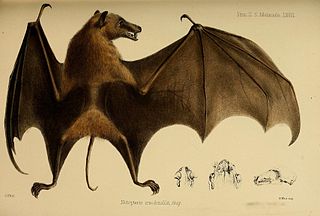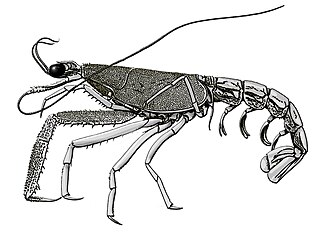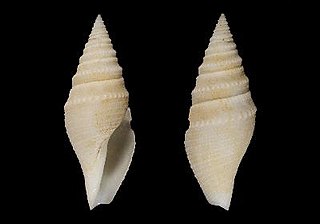Callitris neocaledonica is a species of conifer in the family Cupressaceae. It is found only in New Caledonia. It is threatened by habitat loss.

Notopteris is a genus of megabat in the family Pteropodidae. It contains the following species:

Astelia waialealae is a rare species of plant in the Asteliaceae family that is endemic to the island of Kauaʻi of the state of Hawaii in United States. It inhabits montane bogs within the vicinity of the Alakaʻi Swamp on the island's central plateau. A. waialealae is threatened by habitat loss and habit disturbance by feral pigs; there are only about 26 plants remaining. It is a federally listed endangered species.
Oxanthera is a genus of flowering plants in the citrus family, Rutaceae. They are endemic to New Caledonia. They are known commonly as false oranges.
Oxanthera neocaledonica is a species of plant in the family Rutaceae. It is endemic to New Caledonia.

Astelia is a genus of flowering plants in the recently named family Asteliaceae. They are rhizomatous tufted perennials native to various islands in the Pacific, Indian, and South Atlantic Oceans, as well as to Australia and to the southernmost tip of South America. A significant number of the known species are endemic to New Zealand. The species generally grow in forests, swamps and amongst low alpine vegetation; occasionally they are epiphytic.
Astelia trinervia is a species of rhizomatous tufted perennial native to New Zealand. An example occurrence of this species is in the North Island's Hamilton Ecological District, where it occurs in the understory associated with Blechnum discolor and overstory forest elements of rimu and nothofagus trees.
Typhina neocaledonica is a species of sea snail, a marine gastropod mollusk in the family Muricidae, the murex snails or rock snails.
Typhina is a genus of sea snails, marine gastropod mollusks in the family Muricidae, the murex snails or rock snails.

The New Caledonia blossom bat is an uncommon species of megabat in the family Pteropodidae. The species lives in caves in northern New Caledonia, and forms colonies of up to 300.

Laurentaeglyphea neocaledonica is a species of glypheoid lobster, and the only species in the genus Laurentaeglyphea. It is known from a single specimen collected on a guyot in the Coral Sea between Australia and New Caledonia. It is thought to be an active predator with colour vision, unlike its nearest living relative, Neoglyphea inopinata.

Astelia nervosa, also known as mountain astelia or, along with a number of other species, as bush flax, is a herbaceous plant native to New Zealand. A. nervosa has long, flexible, leathery leaves that are light green and grey in colour. The flowers are light brown to red in colour. The mature fruits are generally orange.

Astelia fragrans, commonly known as bush lily, bush flax or kakaha, is the most common astelia species found in New Zealand. It grows from sea level to elevations of approximately 900 metres.

Astelia menziesiana is a species of plant in the Asteliaceae family that is endemic to the state of Hawaii in the United States. Hawaiian names for the plant are kaluaha, paʻiniu, or puaʻakuhinia. It is a non-woody, clumping plant that grows from 1 to 3 feet in width/height. The plant can grow on tree branches and trunks as an epiphyte or in the ground. Leaves are silvery-green or green on top; undersides may be white, gold or silver. Flowers bloom in long spikes in colors including yellow, purple and red. Male and female flowers are on separate plants. Female plants have small orange-yellow berries which are eaten by birds. Two other species: Astelia argyrocoma and the rare and endangered A. waialealae are restricted to the island of Kauaʻi.

Bathytoma neocaledonica is a species of sea snail, a marine gastropod mollusk in the family Borsoniidae.

Astelia alpina called pineapple grass, silver astelia, or perching lily is a commonly found species in alpine and subalpine areas of Tasmania and the Australian Alps. It is a perennial herb that typically dominates its environment by growing in dense clusters, called mats, in alpine bogs. There are two subspecies: Astelia alpina var. novae hollandiae from New South Wales and Victoria and Astelia alpina var. alpina endemic to Tasmania. Both subspecies appear very similar to each other. The species was originally described by Robert Brown.

Mitrella neocaledonica is a species of sea snail, a marine gastropod mollusk in the family Columbellidae, the dove snails.
Otitoma neocaledonica is a species of sea snail, a marine gastropod mollusk in the family Pseudomelatomidae, the turrids and allies.

Anagotus oconnori or astelia weevil is a large flightless weevil found in New Zealand. It was first collected on Mount Quoin in Wellington from Astelia by Mr A.C. O'Connor after whom this species was named.












